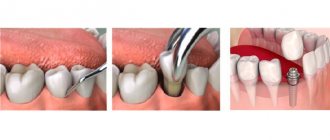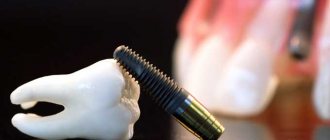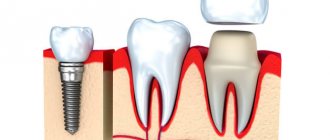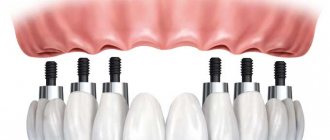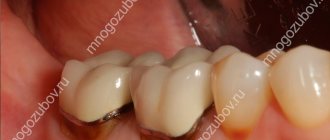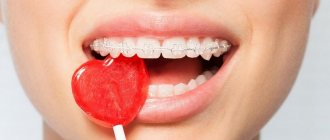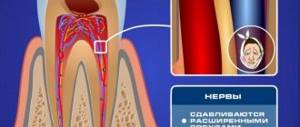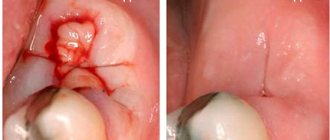Author of the article: Akhtanin Alexander Alexandrovich, orthopedic dentist, implantologist
As with any surgical procedure, there are many external and internal factors that can cause complications during the treatment process or even its failure. Dental implantation is no exception.
While the success rate of implant placement is becoming impressive, some patients do experience some complications. This article discusses the 7 main causes of possible problems with dental implants.
Is it possible for an implant to fall out and how often does it happen: probable causes and consequences
Article navigation
- How to identify the problem
- Causes
- - doctor's actions
- - patient actions
- Rejection after a few years
- Assessment and diagnosis
- Methods for solving the problem
Question for a specialist
Losing a dental implant is a fairly rare situation. This can happen either within 2–3 weeks after surgery to install the implant, or after several years of use for various reasons. These include medical errors or improper actions by the patient. In this case, it is possible to lose fixation not of the metal rod itself, but of its components - the gum former or temporary plug. What symptoms indicate a complication of implantation, for what reasons this happens, what to do if a dental implant falls out, we will discuss in detail in this article.
Symptoms
Already at the very beginning of the rejection process, the patient may feel unpleasant primary symptoms manifested in the form of swelling, bleeding, and pronounced pain. If you do not immediately consult a doctor, the intensity and number of symptoms increase. The patient develops :
- mobility of the prosthesis or its parts;
- a feeling of pain in the implant area that persists for a long period;
- increased body temperature that appeared a few days after surgery;
- the appearance of pus in the area of the installed structure;
- the appearance of an unpleasant odor from the mouth;
- changes (even inflammation) of the gum cuff.
Attention ! What to do if any unusual symptoms and sensations appear? In order not to aggravate the inflammatory process and not to lose the implant, consult a doctor immediately.
In some patients, the cause of rejection may be an allergic reaction to titanium root. This happens:
- inflammation of the salivary glands;
- soreness and discomfort in the throat;
- microcracks and ulcers on the oral mucosa;
- bitter or metallic taste in the mouth;
- increased salivation or, conversely, dry mouth;
- coating on the tongue.
If you ignore the manifestations of allergies in the oral cavity, a life-threatening condition may develop - Quincke's edema!
What signs can be used to determine that the implant has lost stability and fixation?
Even before visiting a doctor and carrying out a professional diagnosis, several clear signs can help you understand that something is wrong with the installed implants. The following symptoms indicate this:
- change in the color of the gums at the site where the rods are installed: redness, appearance of a bluish tint,
- the formation of slight swelling around the implants,
- loose fit of the mucous membrane to the artificial structure, it moves slightly away from the crowns,
- the appearance of not strong, but noticeable pain when chewing, pressing on the implant and the mucous membrane around it,
- development of slight bleeding from the hole surrounding the implant,
- the occurrence of an unpleasant odor, the source of which is the implant area,
- increase in body temperature to 38–39°C,
- purulent discharge from the tissues surrounding the implant,
- loss of stability of the implant, obvious mobility of itself or its individual elements, mobility of the prosthesis.
New teeth in 1 day - All-ON-4 - 180,000 rub.
All inclusive!
3D modeling of the structure with a prosthesis, implantation of 4 Osstem implants, installation of a fixed prosthesis on the same day. Free consultation with an implantologist +7 (495) 215-52-31 or write to us
All these symptoms, both together and separately, indicate a developing pathology and require immediate consultation with a doctor. In the postoperative period, in the first few weeks, this should not be attributed to tissue injury. The chances of a favorable outcome and the ability to save the implant are greater if you pay attention to even minor manifestations.
Possible reasons for the loss of artificial structures
Implant surgery is a strict surgical protocol with step-by-step procedures. Its scrupulous observance, both during preparation and direct surgical intervention, and during the rehabilitation period, is mandatory. If the methodology and requirements are violated, the doctor makes mistakes and the patient fails to follow recommendations, complications arise.
When a dental implant falls out, this indicates an extreme degree of complication, which is preceded by mucositis and peri-implantitis - first superficial, and later deep inflammation of the tissues around the implant. These, in turn, are caused by the accumulation of plaque on the surface of the rod and other reasons.
The reasons are identified, which are based on the doctor’s mistakes, and those for which the patient is responsible. We can talk about the wrong actions of a specialist if the implant is rejected in the first few weeks after its installation. In this case, unscrupulous doctors may tell their patients that their body simply “did not accept” the foreign body. However, this should be questioned, since modern methods of preparing patients and performing surgery almost eliminate this situation. Rejection of structures occurs, according to official data[1], in 2–5% of cases.
In addition to the implant itself, its individual elements can lose stability - the gum former or the plug (used in a two-stage implantation protocol). They can get unscrewed or fall out due to a mismatch with the size and shape of the implant or a loose connection. It is also possible for the crown to detach from the implant shaft or for the screw method to loosen due to unwinding. For this reason, cement connection of implants and prostheses is preferable.
What to do if the pin is rejected?
Implant rejection is a pathological process that leads to disruption of the connection between the tissues of the jaw and the artificial root.
This development of the situation is recognized by dentists as the most serious complication after prosthetics. Rejection occurs in approximately 1-5% of cases . The healing time ranges from approximately 2-4 months on the lower jaw to six months on the upper jaw due to its more complex structure.
A successful result depends not only on the material from which the dental pin is made, and the individual characteristics of the patient’s body.
Implant rejection due to doctor's actions
The positive outcome of the operation in the first stages - during the period of preparation and surgical intervention - depends 90% on the professionalism and experience of the implantologist. That is why the responsible choice of a specialist is so important.
What to pay attention to when coming for a consultation with a particular specialist, read the material “How to choose a doctor and clinic?”
What mistakes can a doctor make at different stages of implantation, and this will lead to tissue inflammation and rejection of the structure:
- during preparation: assessment of the condition of bone tissue and the oral cavity based on an orthopantomogram (OPTG), rather than a more detailed computed tomography (CT), which does not allow one to fully verify the safety of implantation in a particular area of the bone,
- incomplete collection of the patient's medical history, lack of data on chronic diseases and contraindications for implantation, absolute or relative. Special conditions are not taken into account, such as periods of menstruation or menopause in women, long-term smoking and alcohol intake before surgery,
- during planning: illiterate choice of place for the implant, its location in too thin bone, close to the roots of living teeth,
- during a surgical operation: deviation from the rules of sterility, entry of bacteria, saliva into the hole, use of implants not intended for the protocol used, overheating of the bone during drilling, nerve damage, leaky connection of implant parts, incorrect positioning of the rod in the bone, excessive deepening of the implant or creating a hole that is too wide for him,
- during the period of prosthetics: irregularities in the manufacture of the prosthesis, uneven load distribution, overload of the structure at certain points, implantation of only one row without taking into account the work of the opposite one, cement getting into the socket, etc.
Why can a gum abutment fall out?
- The reason may be a loose connection due to the titanium rod being installed too deeply. As a result, bone tissue grows, preventing the molder from being properly fixed.
- The development of an inflammatory process due to insufficient oral hygiene;
- The rod does not adhere tightly to the bone because its density is too low.
Developers of modern implantation systems see the creation of structures that are natural for the oral cavity as a priority. In particular, biocompatible titanium is used.
The thread of the implant allows installation with the most durable fixation and minimal trauma. The body perceives such structures as family.
The duration of engraftment depends on the characteristics of a particular organism.
What role does the patient's actions play?
A competently performed operation by a doctor does not guarantee the absence of complications, since during the rehabilitation period most of the responsibility for the condition of structures and the oral cavity falls on the shoulders of the patient. The engraftment of the implant and its further operation depend on how he follows the surgeon’s recommendations and monitors hygiene.
“In my situation, after dental implantation, the consequences were unpredictable. I put in a tooth, before this I walked for 15 years without it and nothing happened, but the doctors finally persuaded me. They said: “You will forget about the problem for the rest of your life.” But as a result, I only lived with the new tooth for 5 years. First, my gums hurt, then it became loose, and the doctor pulled it out for me directly with my hands. They pulled it out and threw it away along with the money I spent on it.”
eskrei, review from otzovik.com
Why do implants fall out? Moreover, a situation is possible when the crown simply falls out due to loosening of the fastening, and it happens that the implant with the pin falls out, that is, the whole thing. Complications in the form of peri-implantitis and implant rejection are possible under the following circumstances:
- unwillingness or inability to give up bad habits during the rehabilitation period: smoking and drinking alcohol increase the risk of rejection,
- exceeding the permissible load on the implant: this is possible both at the beginning, when the patient begins to eat solid foods ahead of time, and after, when the implant has taken root and, having gotten used to the new teeth, the patient forgets about the ban on eating too hard foods, gnawing seeds and nuts,
- ignoring recommendations for taking certain medications during the period of osseointegration,
- the patient does not regularly and carefully monitor artificial structures and does not take care of the oral cavity, which is a consequence of the deposition of bacterial plaque and the appearance of inflammation. With the appearance of tartar, the situation worsens and over time affects the bone structures,
For information on how to properly care for implants and dentures installed on them, read the article on the website “Care for the oral cavity and dentures after implantation.”
How much does it cost on average in Moscow?
Treatment of complications
| Name of service | Cost, rub. |
| Periodontal applications in the area of 1 tooth | 370 |
| Application of a protective periodontal bandage | 400 |
| Laser therapy of the gum mucosa | 490 |
| Implant removal | 6900 |
| Implantation of osteoconductive material in the area of 1 tooth | 10900 |
| Implantation of a protective membrane (1 tooth) | 12900 |
Gum plastic surgery
| Name of service | Cost, rub. |
| Plastic surgery of marginal gums | 1200 |
| Gingivoplasty (1 tooth) | 1500 |
| Plastic surgery of marginal gums (segment) | 3500 |
| Plasty of gingival margin recession | 3500 |
| Flap surgery in the area of one tooth | 3500 |
| Smile line plastic surgery | 4000 |
| Gingivoplasty (1 tooth) using laser | 4000 |
| Gingivoplasty (segment) | 4500 |
| Flap surgery (three teeth) | 7000 |
| Gingivoplasty (segment) using laser | 10000 |
| Flap surgery (segment) | 10000 |
| Flap surgery (whole mouth) | 30000 |
Assessment and diagnosis of complications that have arisen
After the first symptoms are detected, professional diagnostic methods make it possible to reliably determine the cause and depth of the pathological process. For this purpose, radiography or computed tomography is used. They allow you to assess the condition of the bone tissue at the time when the implants fell out. A year after installation, the picture will be different than after one month of wearing implants. After diagnosis using these methods, the doctor gives his assessment and offers options for solving the problem.

